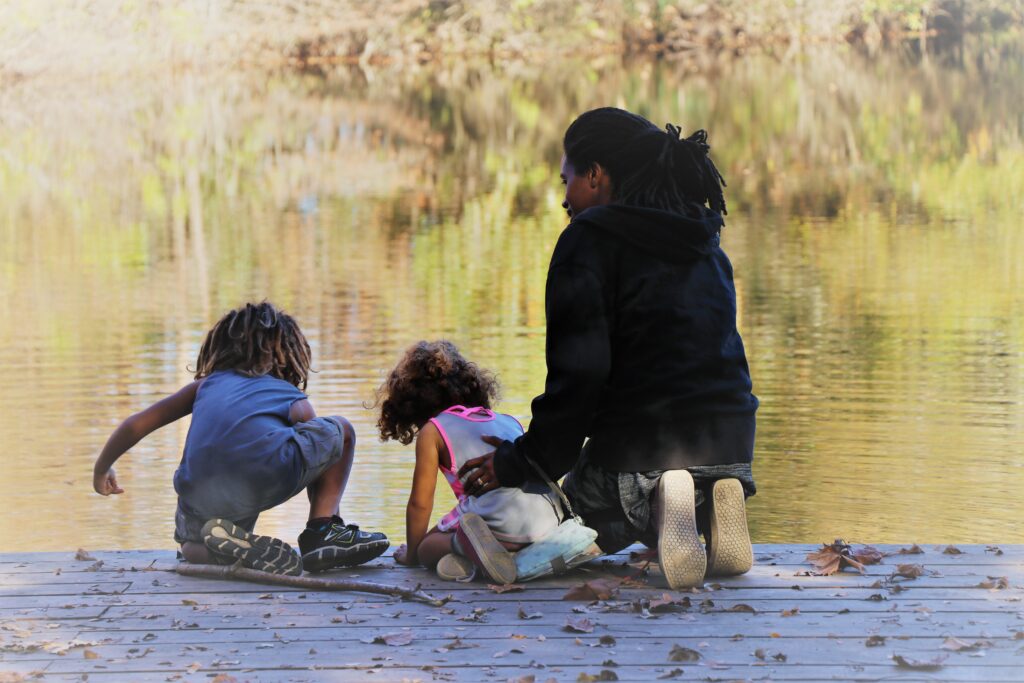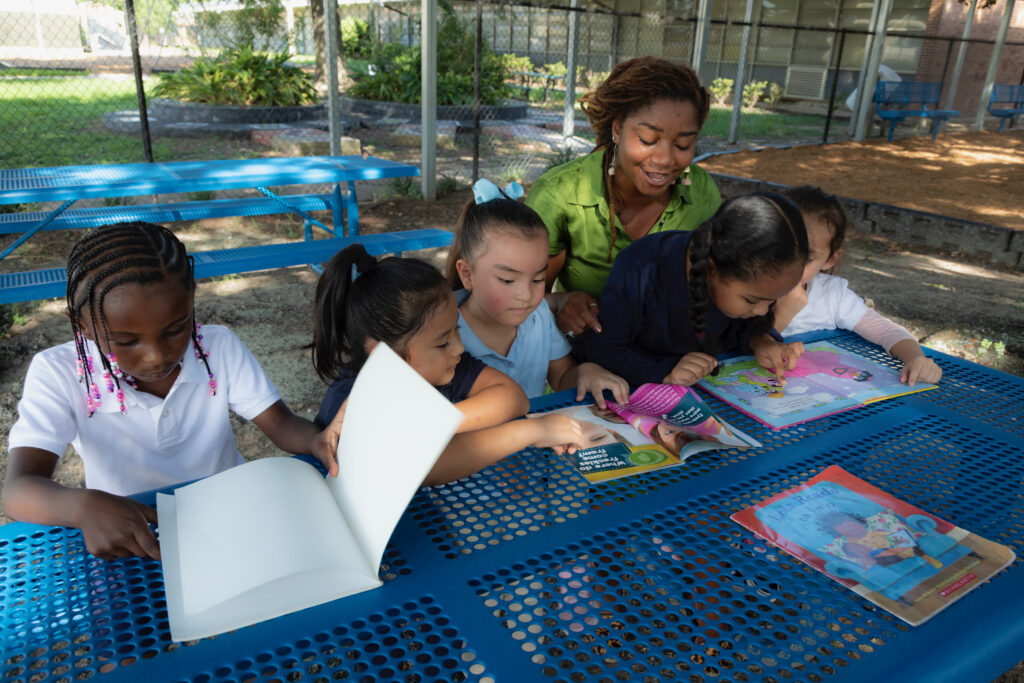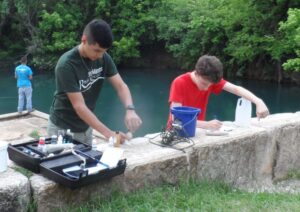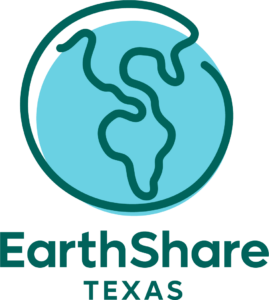EarthShare Texas, a nonprofit federation, is at the forefront of environmental conservation and sustainability, channeling its efforts towards seven distinct impact areas that shape the future of our planet. In this blog, we delve into the heart of EarthShare Texas’ mission, exploring the organization’s commitment to making a meaningful difference in areas such as water resources, land conservation, environmental justice, and more.
EarthShare Texas’ mission is to empower mission-driven members to pursue positive environmental and health impacts across the Lone Star State for the benefit of all. Right now, Texas is facing unprecedented change, and with it, the opportunity to shape a sustainable future for the state. With its abundant renewable energy resources, diverse ecosystems and passionate residents, Texas has the potential to set an inspiring example for others to follow. In order to preserve the Texas environment, we must act for the future – today.

Photo by Gene Fisseler
EarthShare Texas’ Membership Amplifies Collective Impact Across Texas
EarthShare Texas is proud to have a diverse network of nonprofit members distributed across the expansive landscape of seven distinct regions in Texas. From the vibrant cities to the serene coastal prairies, our nonprofit partners operate on the front lines of environmental conservation, bringing their expertise and dedication to local communities. Each region represents a unique environmental context, and our members collaborate to address specific challenges, fostering a collective impact that resonates across the entire state. This geographical diversity allows for effective initiatives, ensuring that our environmental efforts are tailored to the needs of each region while collectively contributing to the overall well-being of Texas’ natural resources.
EarthShare Texas Key Impact Areas
EarthShare Texas’ network of 30+ environmental and conservation organizations is a powerhouse that has collectively conserved 19,000+ acres of Texas land, removed over 2 million pounds of trash from waterways, and organized 169,000 hours of volunteer opportunities. The power of collective impact is infinite; read about EarthShare Texas’ seven impact areas below.
Advocacy and Environmental Justice
In the United States, inadequate access to resources is correlated to demographics of diversity, including race, gender, ability, age, and culture (Sierra Club Lone Star Chapter). These members galvanize public support for systemic environmental policy change (on the local, state, and federal levels) that impact the health and safety of Texas communities. Their work organizes, educates, and/or lobbies for inclusive environmental justice. They empower all people to advocate and take action towards a green future.
Bike Texas
BikeTexas advances bicycle access, safety, and education. We encourage and promote bicycling, increased safety, and improved conditions. We unite and inspire people and provide a cohesive voice for people who ride bikes in Texas.
The Sierra Club Foundation
“We are the oldest grassroots environmental organization in Texas. We believe our open spaces, clean water, and natural resources should be protected so that current and future generations may enjoy them. In addition to our state chapter office in Austin, we are blessed with several regional groups in Texas that provide wonderful opportunities to explore, enjoy, and protect the state’s natural wonders.”
Environmental Defense Fund
“We are a global nonprofit organization tackling climate change — the greatest challenge of our time. Our bold, game-changing solutions put people at the center of all we do. Our goals: stabilize the climate, strengthen people and nature’s ability to thrive, and support people’s health.”
Sustainable Food Center
“Sustainable Food Center transforms the food system to nourish our health, land and livelihood. We envision a just, equitable, and regenerative food system where people and the environment thrive.”
Public Citizen
“Public Citizen is a nonprofit consumer advocacy organization that champions the public interest in the halls of power. We defend democracy, resist corporate power, and fight to ensure that the government works for the people – not big corporations. Founded in 1971, we now have 500,000 members and supporters throughout the country.”
Texas Campaign for the Environment Fund
“Empowering Texans to change corporate and governmental policy through sustained grassroots organizing campaigns. Working for a Texas free from pollution.”
Environmental Education
[Environmental education] has led to a number of positive impacts, from improving academic performance, to enhancing critical thinking skills, to developing personal growth and life-building skills including confidence, autonomy, and leadership (NAAEE). These nonprofits educate on a wide variety of environmental knowledge for multiple generations. Their work inspires partnership between people and nature and fosters continued learning across diverse Texas ecology. These organizations equip human, nonprofit, and government collaboration to sustain the functionality and beauty of the natural systems in our state.

Photo by Alicia Wells
Audubon Foundation of Texas
“Audubon’s mission is to conserve and restore natural ecosystems, focusing on birds, other wildlife, and their habitats for the benefit of humanity and the earth’s biological diversity. Audubon Foundation of Texas (AFT) is a non-profit established to support Audubon Texas, Audubon Centers and Sanctuaries in Texas and the affiliated Audubon local chapters.”
Citizens’ Environmental Coalition
“Our vision is an environmental community recognized as a vital part of the fabric of our society.
We connect concerned citizens and community leaders with well over 100 diverse environmental organizations. We share, support, and enhance their efforts and environmental advocacy. We do this through our programs, which include events that enhance understanding, and publications that give a balanced perspective on environmental issues.”
Austin Youth River Watch
“Austin Youth River Watch transforms and inspires youth through environmental education, community engagement, and adventure. As a result of our work, youth are better prepared to create positive outcomes for themselves and the environment, ensuring a better future for all.”
Keep Texas Beautiful
“Keep Texas Beautiful (KTB) is a non-profit organization dedicated to making Texas the best place to live, work, and play! Our mission is to inspire and empower Texans to make their communities clean and beautiful. We provide resources for community improvement projects, clean-ups, and youth engagement efforts across the state. Our Keep Texas Recycling program provides technical assistance, education, and access to markets to increase recycling in rural and underserved communities.”
Lady Bird Johnson Wildflower Center
“The University of Texas at Austin Lady Bird Johnson Wildflower Center uses native plants to restore and create sustainable, beautiful landscapes. We carry out our mission to inspire the conservation of native plants through our gardens, research, education, and outreach programs. In doing so, we improve water quality, provide habitat for wildlife, and enhance human health and happiness. In 2017, we were officially designated the Botanic Garden and Arboretum of Texas.”
Infrastructure and Sustainable Design
Texas’ population is now over 30 million; second only to California. Texas is the 4th fastest growing state (U.S. Census, 2022). These nonprofits help research, promote, and create sustainable methods for equitable green infrastructure and renewable energy. They advance education and advocate practices that are reciprocal to the health and life cycle of products, people, and habitats. They develop partnerships with institutions, businesses, and community organizations to amplify and distribute their work. These initiatives are vital to the growth and development of Texas.
Center for Maximum Potential Building Systems
“The Center designs and tests innovative programs that integrate air, water, food, energy, and material systems to build healthy and sustainable communities. Through the creation of Protocols, Policies, and Prototypes, the Center inspires ecologically balanced environments, stewards natural resources, and elevates community resilience and economic vitality.”
Texas Solar Energy Society
“Because we envision a world where our children will grow up in a clean, safe climate, TXSES supports bold solutions to educate, inspire and enable every Texan to adopt solar energy as part of an equitable, 100% clean energy future.”
State of Texas Alliance for Recycling
“STAR is a registered 501c3 nonprofit on a mission to advance recycling through partnerships, education, and advocacy for the benefit of Texas. We work to help recycling professionals, educate the public and lawmakers, expand access to recycling, develop infrastructure, and grow recycling markets in Texas.”
Land Conservation
Changing land use and fragmentation alters and threatens natural habitats (TPWD, 2023). Currently, approximately 95% of Texas land is privately owned, posing unique challenges for land and wildlife conservation. These nonprofits work alongside land owners and other entities to conserve and preserve natural resources and local ecology forever. Stretching across the Lone Star State, these organizations take responsibility for state and national parks, wetlands, prairies, and more.

Photo by Loren Riemer
Bayou Land Conservancy
“We preserve land along streams for flood control, clean water, and wildlife. Flooding in our region is one of the greatest threats to the health of our communities. The preservation of natural floodplains is critical to reducing flood risk to people, homes, schools, and businesses. Protecting and preserving natural land is the best first line of defense against flooding.”
Coastal Prairie Conservancy
“Sustaining a resilient Texas by preserving coastal prairies, wetlands, farms, and ranches to benefit people and wildlife forever. It’s more important than ever for us to look at ways to conserve the coastal prairie. We will continue to lead that charge and make sure we have natural spaces for you, your kids, and your grandkids to enjoy in the years to come.”
Big Bend Conservancy
“Big Bend Conservancy’s mission is to preserve, enrich, and conserve the unique resources of Big Bend National Park and the Rio Grande Wild and Scenic River through philanthropic efforts and in partnership with the National Park Service. Their vision is to preserve the natural beauty and unique resources of the park and the river for future generations through harmonious partnerships.”
Texas Parks and Wildlife Foundation
“Texas Parks and Wildlife Foundation’s mission is t
o ensure that all Texans, today and in the future, can enjoy the wild things and wild places of Texas. Since 1991, Texas Parks and Wildlife Foundation has raised and invested private funds to advance Texas’ proud outdoor traditions and conserve our state’s wildlife, habitat and natural resources. Our vision is for all Texans to have access to the wild things and wild places in our state, both now and for generations to come.”
Guadalupe-Blanco River Trust
“The mission of the Guadalupe-Blanco River Trust is to preserve the unique natural heritage of the Guadalupe watershed for future generations, by protecting open landscapes, working farms and ranches, and wildlife habitat.”
Parks and Public Space
City parks provide access to recreational opportunities, increase property values, spur local economies, combat crime, and protect cities from environmental impact (City Parks Alliance). Parks and Public Spaces are essential components of community, and these nonprofits maintain and/or establish the spaces for the enjoyment of all. They empower and engage community members to take care of these spaces through rewarding programs and volunteer opportunities.

Photo by Tom Callins
Austin Parks Foundation
“Founded in 1992, Austin Parks Foundation (APF) is dedicated to partnering with our community to enhance people’s lives by making our public parks, trails and green spaces better through volunteerism, innovative programming, advocacy and financial support.”
Greens Bayou Coalition
“Greens Bayou is one of Houston’s most valuable natural resources as it serves as an invaluable corridor for flood water drainage, with numerous new detention basins along its route to the Gulf. Our bayou also increases the quality of life for the 800,000 plus residents along its watershed as parks and trails are built to connect Northwest Houston to Uptown to Downtown to Southeast Houston. The Coalition is working towards making the Greens Bayou corridor a wonderful, healthy place to live, work and play. Come join in the excitement as we discover OUR BAYOU together!”
Buffalo Bayou Partnership
“Buffalo Bayou Partnership is the non-profit organization leading the planning, design, activation, and stewardship of inspiring spaces along the 10-mile stretch of Buffalo Bayou from Shepherd Drive through downtown and eastward to the Port of Houston Turning Basin.”
SPARK School Park Program
“The SPARK School Park Program works with schools and neighborhoods to develop community parks on public school grounds. Since 1983, SPARK has built over 200+ community parks throughout the Houston/Harris County area. Currently, there are 150+ active SPARK Parks. Each park is unique, with its design based on ideas and needs of the school and surrounding neighborhoods. While all of the parks are different, a typical park consists of modular playground equipment, a walking trail, benches, picnic tables, trees, an outdoor classroom, and a public art component.”
Ecology Action
“We develop equitable energy, transportation, and water programs that build community resilience to climate change. There are accessible choices for nearly everyone to lower carbon emissions in these sectors. We offer programs aimed at helping individuals, businesses and communities take sustainable action for people and the planet.”
TreeFolks
“TreeFolks’ mission is to empower Central Texans to build stronger communities through planting and caring for trees. TreeFolks engages thousands of volunteers and community groups to plant trees in public parks, preserves, and schoolyards. TreeFolks works to restore forests after natural disasters such as the forest fires of 2011 in Bastrop County, the devastating Blanco River floods of 2015, and now in the floodplains of Travis County. TreeFolks provides free, year-round education opportunities for all ages with an emphasis on hands-on, experiential learning using the urban forest as our teacher. TreeFolks partners with the City of Austin to give trees to qualifying Austinites in the urban core through tree giveaways and consulting.”
Water Resources
Many different Texas groups rely heavily on water, but Texas rivers and wildlife cannot thrive without it (Texas Living Waters). These members fight for clean, accessible water in all its interconnected formations – watersheds, rivers, bays, creeks, and aquifers. Their work is at the intersection of people, policy, and consumer production. They promote community organizing, cleanups, and develop forward-thinking solutions for the preservation of water sources and its inhabitants.
Clean Water Fund
“Clean Water Fund’s mission is to develop strong grassroots environmental leadership and to bring together diverse constituencies to work cooperatively for changes that improve their lives, focused on health, consumer, environmental and community problems.”
Galveston Bay Foundation
“Galveston Bay Foundation is a conservation nonprofit that has served as guardian of Galveston Bay since 1987. Our mission is to preserve and enhance Galveston Bay as a healthy and productive place for generations to come. We work to facilitate a true cross-section of Bay interests through creative, inclusive and forward-thinking solutions to the challenges confronting Galveston Bay.”
Greater Edwards Aquifer Alliance
“The Greater Edwards Aquifer Alliance (GEAA) is a 501(c)(3) nonprofit organization that promotes effective broad-based advocacy for protection and preservation of the Edwards and Trinity aquifers, their springs, watersheds, and the Texas Hill Country that sustains them. The Edwards Aquifer is the source of the largest springs in Texas and the sole source of drinking water for more than 2 million Central Texas residents.”
San Marcos River Foundation

Photo by San Marcos River Foundation
“SMRF was established in 1985 to protect public access and preserve the San Marcos River, focusing on protecting the flow from aquifer-fed springs,improving the water quality and protecting the beauty of the area with parks and regular clean-ups.”
Save Barton Creek Association
“Since 1979, the Save Barton Creek Association has worked to preserve our natural heritage through our public education, advocacy, and conservation programs. We are a nonprofit citizen group working to protect and conserve the six watersheds of the Barton Springs Edwards Aquifer (Barton, Bear, Little Bear, Onion, Slaughter and Williamson). Since incorporating in September 1979 in response to community concerns about the impact of urbanization on Barton Creek and Barton Springs, SBCA has been one of the lead conservation organizations in Austin working to ensure that future generations may enjoy the cool, clean waters of Barton Springs.”
Wildlife
Texas ranks third in the nation for endemic vertebrate species, with 126 such species found nowhere else on the globe. However, Texas has a total of nearly 180 threatened or endangered animals and plants… these species would be the most vulnerable to climate change and complicating factors such as habitat loss and fragmentation (TPWD). These nonprofits prioritize animals in need of protection, conservation, and rehabilitation throughout Texas, the U.S., and/or the world. The specialized care, research, and education these members generate supports the survivability of multiple species. Overall, they advocate and shelter the remarkable and complex wildlife all around us.
Bat Conservation International
“Founded in 1982, Bat Conservation International has grown into a globally recognized conservation organization dedicated to ending bat extinctions. Working together, our goal is to redefine what is possible in global conservation, through the utilization of cutting-edge tools, technology, and training to create a real, measurable impact. Our mission is to conserve the world’s bats and their ecosystems to ensure a healthy planet.”
National Wildlife Federation
“America’s experience with cherished landscapes and wildlife has helped define and shape our national character and identity for generations. Protecting these natural resources is a cause that has long united Americans from all walks of life and political stripes. To hunters, anglers, hikers, birders, wildlife watchers, boaters, climbers, campers, cyclists, gardeners, farmers, forest stewards, and other outdoor enthusiasts, this conservation ethic represents a sacred duty and obligation to protect and build upon our conservation heritage for the sake of wildlife, ourselves, our neighbors, and—most of all—for future generations.”
Blackland Prairie Raptor Center
“Named after the tallgrass prairie that once covered more than 23,500 square miles of Texas from the Red River to San Antonio, Blackland Prairie Raptor Center’s mission is to promote and enhance populations of raptors through rehabilitation, conservation, and education initiatives.”
Wildlife Rescue and Rehabilitation
“Their mission is to rescue, rehabilitate, and release native wildlife and to provide sanctuary, individualized care, and a voice for other animals in need. Wildlife Rescue receives over 10,000 wild animals every year. Among these are opossums, raccoons, bobcats, coyotes, skunks, squirrels, and many other mammals along with over 100 species of birds and many reptiles.”
EarthShare Texas: One environment. One simple way to care for it.
EarthShare Texas stands as a beacon of hope and action in the realm of environmental conservation, driven by its commitment to seven crucial impact areas. Each facet of EarthShare Texas’ mission plays an integral role in shaping a sustainable future, and the collective efforts across these impact areas underscore the organization’s dedication to preserving our planet for current and future generations. It is evident that EarthShare Texas continues to be a catalyst for positive change in the environmental space. Through collaboration, partnership-building, and unwavering determination, EarthShare Texas inspires us all to take an active role in nurturing and safeguarding the environment we share. The journey towards a more sustainable and resilient world is ongoing, and EarthShare Texas remains steadfast in its mission to lead us towards a brighter, greener future.
Sign Up for EarthShare Texas' Newsletter
"*" indicates required fields



